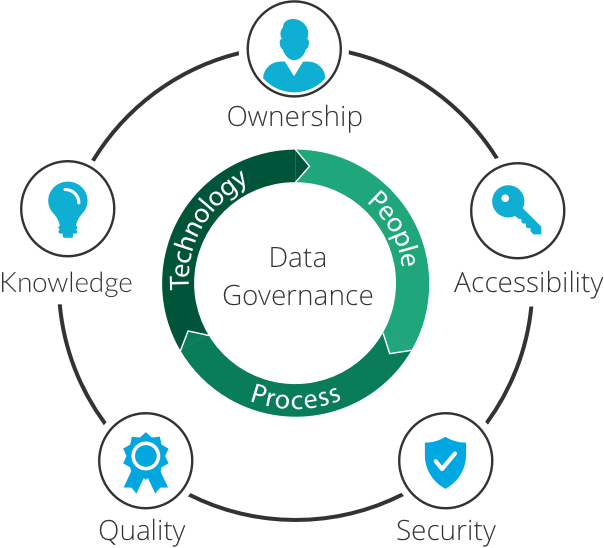DATA MATURITY ASSESSMENTS
Instructions
Data Access Management
Data Quality
Data Literacy
IT Data Management
General
Results
Select the maturity level of your organization
Refer to the answer levels below to determine your organization’s answer.
The questionnaire will calculate your organization’s maturity level for each tab section.
After completing each section, go to the results tab to see your results.
ANSWERS LEVELS
Level 1: No Issues are dealt with as they appear.
Level 2: Beginning The importance is becoming apparent and commonly accepted. Efforts are beginning as the organization determines what is needed.
Level 3: In Progress Policies and documentation are being created to implement a solution. Actions are being taken such as appointing people to positions or installing a tool.
Level 4: Yes The organization is now enforcing policies and procedures for data governance. There is an implemented solution being monitored for success.
Level 5: Absolutely The implemented solution is working and only needs small improvements for optimization. Workflows are redesigned to reduce redundancy.
ANSWERS LEVELS
Level 1: No Issues are dealt with as they appear.
Level 2: Beginning The importance is becoming apparent and commonly accepted. Efforts are beginning as the organization determines what is needed.
Level 3: In Progress Policies and documentation are being created to implement a solution. Actions are being taken such as appointing people to positions or installing a tool.
Level 4: Yes The organization is now enforcing policies and procedures for data governance. There is an implemented solution being monitored for success.
Level 5: Absolutely The implemented solution is working and only needs small improvements for optimization. Workflows are redesigned to reduce redundancy.
ANSWERS LEVELS
Level 1: No Issues are dealt with as they appear.
Level 2: Beginning The importance is becoming apparent and commonly accepted. Efforts are beginning as the organization determines what is needed.
Level 3: In Progress Policies and documentation are being created to implement a solution. Actions are being taken such as appointing people to positions or installing a tool.
Level 4: Yes The organization is now enforcing policies and procedures for data governance. There is an implemented solution being monitored for success.
Level 5: Absolutely The implemented solution is working and only needs small improvements for optimization. Workflows are redesigned to reduce redundancy.
ANSWERS LEVELS
Level 1: No Issues are dealt with as they appear.
Level 2: Beginning The importance is becoming apparent and commonly accepted. Efforts are beginning as the organization determines what is needed.
Level 3: In Progress Policies and documentation are being created to implement a solution. Actions are being taken such as appointing people to positions or installing a tool.
Level 4: Yes The organization is now enforcing policies and procedures for data governance. There is an implemented solution being monitored for success.
Level 5: Absolutely The implemented solution is working and only needs small improvements for optimization. Workflows are redesigned to reduce redundancy.
ANSWERS LEVELS
Level 1: No Issues are dealt with as they appear.
Level 2: Beginning The importance is becoming apparent and commonly accepted. Efforts are beginning as the organization determines what is needed.
Level 3: In Progress Policies and documentation are being created to implement a solution. Actions are being taken such as appointing people to positions or installing a tool.
Level 4: Yes The organization is now enforcing policies and procedures for data governance. There is an implemented solution being monitored for success.
Level 5: Absolutely The implemented solution is working and only needs small improvements for optimization. Workflows are redesigned to reduce redundancy.
ANSWERS LEVELS
Level 1: No Issues are dealt with as they appear.
Level 2: Beginning The importance is becoming apparent and commonly accepted. Efforts are beginning as the organization determines what is needed.
Level 3: In Progress Policies and documentation are being created to implement a solution. Actions are being taken such as appointing people to positions or installing a tool.
Level 4: Yes The organization is now enforcing policies and procedures for data governance. There is an implemented solution being monitored for success.
Level 5: Absolutely The implemented solution is working and only needs small improvements for optimization. Workflows are redesigned to reduce redundancy.
You scored 91
You scored 51
You scored 549
You scored 74
You scored 549
You scored 74
Maturity Model
Recommendations
Q&A
Tab Title 4
Progressive Data Governance Maturity Model
The objective of every data governance maturity model is the same, but neither Gartner nor IBM provide the detail required to overcome the challenges businesses will face. Our approach enables companies to track the progress of their data governance initiatives.
Level 1: Unaware
- Unaware of the importance of data
- No action taken.
- Processes are reactive and generally chaotic.
Level 2: Aware
- There is an awareness of the importance of data.
- Existing data practices are understood and well documented.
- An inventory of data sources is available.
Level 3: Defined
- Data governance rules and policies are defined.
- Data owners and data stewards are identified.
- A governance committee is set up.
- A data catalog is installed.
Level 4: Implemented
- Data governance policies and implementing rules are enforced.
- There is training conducted.
- Data is collected and measured.
- Alerts are set up to monitor data quality issues raised by users.
Level 5: Optimized
- Rules and policies for better efficiency are optimized.
- Redundancies are reduced with redesigned workflows.
- Users tag data to increase discoverability.
The data governance maturity model should be applied to three core areas of data governance: data quality, data access management, and data literacy. The aim is to independently apply this model to each of the three areas and tackle data governance progressively.
You scored 549
You scored 74
To what extent does your organization use data for Recording activity/work with clients?
Extensively 0 / 0
Moderately 0 / 0
A little 0 / 0
Not at all 0 / 0
Don't know 0 / 0
Do you like playing sports?
Yes 0 / 0
No 0 / 0
I hate my job.
No 0 / 0
Yes 0 / 0





